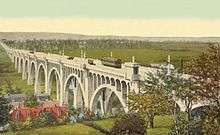Albertus L. Meyers Bridge
| Albertus L. Meyers Bridge | |
|---|---|
 Postcard (dated 1916) depicting Allentown's Eighth Street Bridge. | |
| Coordinates | 40°35′47″N 75°28′16″W / 40.5963°N 75.4712°WCoordinates: 40°35′47″N 75°28′16″W / 40.5963°N 75.4712°W |
| Carries | Two lanes northbound and one lane southbound of 8th Street, from Union Street to Lehigh Street, and 2 sidewalks |
| Crosses | Little Lehigh Creek, Harrison Street and Martin Luther King, Jr. Drive |
| Locale | Allentown, Pennsylvania |
| Official name | Albertus L. Meyers Bridge |
| Maintained by | City of Allentown |
| Characteristics | |
| Design |
Reinforced concrete open-spandrel arch |
| Total length | 2,650 feet (810 m) |
| Width | 45 feet (13.72 m) (deck width) |
| Height | 138 feet (42 m) |
| Longest span | nine 120-foot (36.58 m) broad arches |
| History | |
| Opened | November 17, 1913 |
| Statistics | |
| Daily traffic | 14618[1] |
| Toll | Free |
The Albertus L. Meyers Bridge (also known as the Eighth Street Bridge and unsigned as SR 2055)[1] is a reinforced concrete open-spandrel arch bridge located in Allentown, Pennsylvania in the United States.
When opened for traffic on November 17, 1913, the Albertus L. Meyers Bridge, then known as the Eighth Street Bridge, was the longest and highest concrete bridge in the world.[2]
The bridge spans the Little Lehigh Creek, linking Allentown's center city with the city's South Side. The bridge has seventeen spans and is longer than the more massive Tunkhannock Viaduct of the same type.
History
The Lehigh Valley Transit Company organized the Allentown Bridge Company in 1911 for the sole purpose of building the bridge. The bridge was designed by the engineering firm of B.H. Davis and built by McArthur Brothers of New York City. Costing in excess of $500,000, construction of the bridge required 29,500 cubic yards (22,600 m3) of concrete and 1,100,000 pounds (500,000 kg) of metal reinforcing rods.
The structure operated as a toll bridge from its November 17, 1913 opening until the 1950s, at which time the toll was five cents for an automobile.
The Liberty Bell Line, Lehigh Valley Transit's electric street car line that went to Quakertown, Sellersville, Lansdale, Norristown and Philadelphia ran across the bridge until that interurban service made its last run on the evening of September 6, 1951. On the final return trip from Norristown, in the early morning hours of September 7, car #1006 did not cross the bridge again but went directly to Fairview carbarn, located some distance southwest of the bridge. All rail operations across the bridge ended when the company ceased street trolley service in 1953. The concrete standards that once supported the trolley wire are still standing on the bridge to this day.
Formal naming
The Eighth Street Bridge was formally renamed the Albertus L. Meyers Bridge in 1974.[3] Meyers was a well-known conductor of the Allentown Band and a cornet player in the band of John Philip Sousa. As a boy, Meyers played in the Allentown Band at the opening of this bridge that now bears his name.
The Albertus L. Meyers Bridge was added to the U.S. National Register of Historic Places on June 22, 1988.
Suicides
In the Lehigh Valley area, the phrase "I'm going to jump off the Eighth Street Bridge" is used variously and kiddingly when facing a seemingly insurmountable challenge or challenges.[4] However, like many metropolitan bridges, because of the bridge's height and proximity to a large city population, it has been and continues to be the site of numerous actual suicides.[5][6][7] Since 1913 the bridge has had about 80 documented suicides and an unknown amount of unsuccessful suicide attempts.[8] This has prompted the city to consider adding barriers to make jumping more difficult. These suicides have become a part of the local culture, with claims of ghost sightings on the bridge and a variety of unauthorized makeshift memorials underneath it.
Images
-

Bridge as seen from Martin Luther King, Jr. drive.
See also
- List of bridges documented by the Historic American Engineering Record in Pennsylvania
- Historical and Notable Sites in Allentown, Pennsylvania
References
- 1 2 iTMS: Internet Traffic Monotoring System (Map). PennDOT. Archived from the original on August 23, 2007. Retrieved September 14, 2007.
- ↑ "Historical Allentown". City of Allentown. Retrieved April 23, 2007.
- ↑ Whelan, Frank (June 8, 2005). "Bridge named after musician ** Albertus L. Meyers also was conductor of Allentown Band.". The Morning Call. pp. B.07.
- ↑ "Remain Calm," TheMorningCall.com, September 29, 2008.
- ↑ "Man who jumped from bridge identified". The Morning Call. March 16, 2007. Retrieved April 23, 2007.
- ↑ "Allentown Woman, 58, Leaps to Death from Bridge," The Morning Call, January 22, 2009.
- ↑ "Woman jumps off bridge in suicide," The Morning Call, February 4, 2009.
- ↑ "BRIDGE OF DESPAIR: Eighth Street bridge scene of nearly 80 suicides," TheMorningCall.com, May 6, 2012.
External links
- Historic American Engineering Record (HAER) No. PA-459, "South Eighth Street Viaduct"

